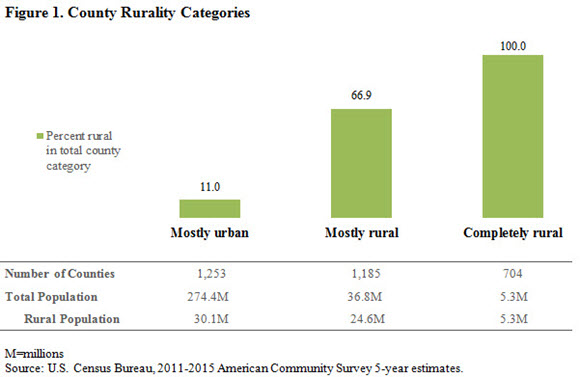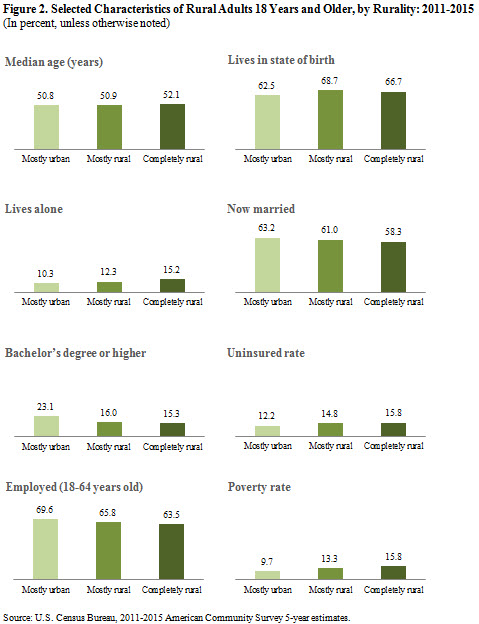Rurality Matters
Rurality Matters
Today, about 60 million residents of the United States live in areas designated as rural by the U.S. Census Bureau. So, what exactly does rural look like? “Rural” can span from the less-populated towns outside of large and small city centers to remote areas in the mountains, plains, and deserts across the nation.
Counties can be a mixture of urban and rural areas. To understand the characteristics of rural residents in different rural settings, we categorized the 3,142 counties in the U.S. into three levels of rurality based on the percentage of the population living in the rural areas of the county. We used the 2010 definition of urban and rural as determined by the decennial census population. The counties were delineated as mostly urban (less than 50.0 percent of the county population lived in rural areas), mostly rural (50.0 to 99.9 percent lived in rural areas), and completely rural (100.0 percent lived in rural areas). Based on these county categories, we identified 704 counties [XLS <1.0 MB] as completely rural, meaning all 5.3 million people lived in rural areas (see Figure 1).
The characteristics of rural residents differed depending on the level of rurality of their county of residence. Let us start with the population of 47 million adults 18 years and older who lived in rural areas. Rural adults in the completely rural counties were older than rural adults in each of the other two county categories (see Figure 2). A higher percentage of rural adults in counties that were mostly or completely rural also lived in their state of birth (68.7 and 66.7 percent) compared with rural adults living in mostly urban counties (62.5 percent). While we cannot tell from these data if people have moved away from their state of birth at some other point in time, the estimates suggest that rural residents more often reside in or return to live in their state of birth over their lifetimes.
As the rurality of a county increased, the percentage of rural adults who lived alone increased, while the percentage who were currently married decreased (see Figure 2). Fifteen percent of rural adults in the completely rural counties lived alone, compared with 10.3 percent of rural adults in mostly urban counties and 12.3 percent in mostly rural counties. About 58 percent of rural adults in the completely rural counties were married, compared with 63.2 percent of rural adults in mostly urban counties and 61.0 percent in mostly rural counties.
The percentages of rural adults with a Bachelor’s degree or higher decreased as the rurality increased, as did the percentages of the working-age adults who were employed (see Figure 2). Fifteen percent of rural adults in completely rural counties had a Bachelor’s degree or higher, compared with 23.1 percent of rural adults living in mostly urban counties, and 16 percent in mostly rural counties. The percentage of employed rural adults 18 to 64 years old was 6 percentage points lower in completely rural counties compared with those in mostly urban counties.
Conversely, the rates of poverty and uninsured for rural adults increased as the rurality of their residence increased. Nearly 16 percent of rural adults living in completely rural counties were uninsured and 15.8 percent were in poverty.
Next, we turn to the 13 million children under the age of 18 who lived in rural areas. Rural children were a lower percentage of the population in the completely rural counties compared with the other county categories (see Figure 3). This is not surprising given that the rural population was older in completely rural counties. The percentage of rural children living in married-couple households decreased as the rurality of their residence increased. About 71.0 percent of rural own children (meaning the unmarried biological, step, or adopted child of the householder) in the completely rural counties lived in married-couple households, about 8.0 percentage points lower than rural children living in mostly urban counties. The percentage of rural children who lived in households headed by grandparents increased with rurality. Almost 10.0 percent of rural children in completely rural counties lived in grandparent-headed households.
The rate of rural children living in poverty was also higher in completely rural counties, compared with rural children in other types of counties (see Figure 3). The rate of uninsurance for rural children in both mostly rural and completely rural counties was not statistically different (about 8.0 percent); however, it was higher than the rate of uninsurance for rural children in mostly urban counties (6.5 percent).
What we can see from these comparisons is that rural does not imply a single type of community. In terms of the characteristics of the rural population, rurality matters.
For more information on how the Census Bureau defines urban and rural geographies, see our new brief Defining Rural at the U.S. Census Bureau.








